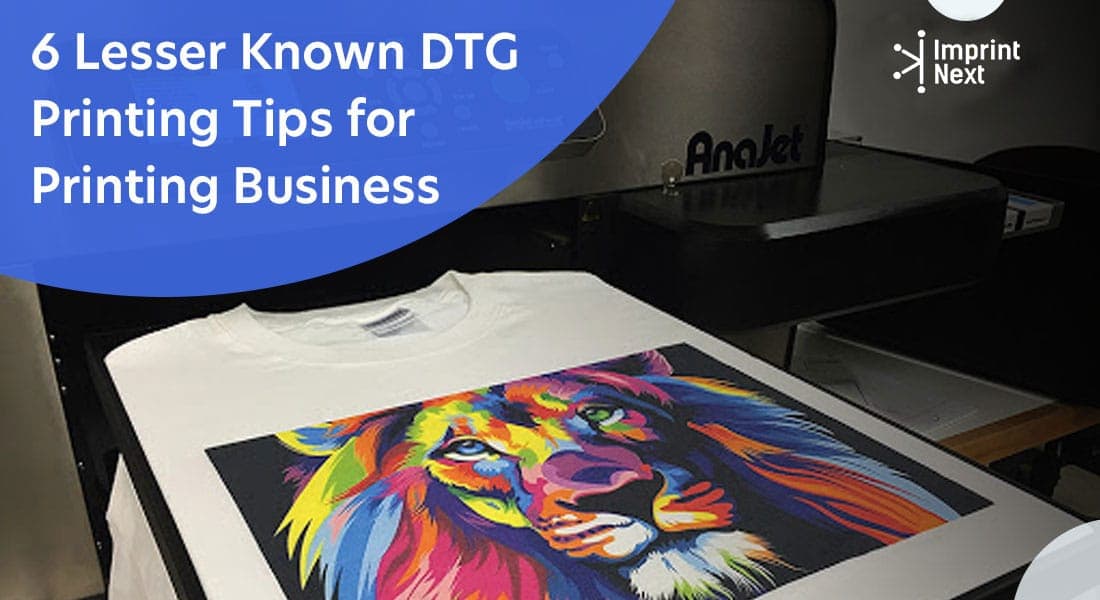
Last Updated on: 25th April 2021, 11:44 pm
Direct-to-garment(DTG) printing is a relatively simple process as compared to other decoration methods. Because in direct-to-garment printing, you follow a few simple steps like creating a graphic, pre-treating a shirt, placing it on a DTG printer, and finally printing it.
Although it seems to be simply by following a simple procedure of DTG printing, there are certain tricks you can use to make the printing task a lot easier and simpler.
You have to keep in mind that, in most decoration methods, print quality does not depend on the garment type. Whereas in DTG printing, it does.
The choice of a garment has an impact on print quality in the case of direct-to-garment printing.
So, you have to do much choosing the right printing ink for a particular type of garment. Sometimes, you may avoid direct-to-garment printing on 100% spun cotton garments for compromising print quality.
You are doing a direct-to-garment printing business, and you cannot be too picky to use your free will. Most importantly, you must prevent DTG print fade after curing.
In any business, “the customer is the king.” You have to fulfill their needs to make your business successful.
Therefore, you have come to the right place to get the best tricks and methods to overcome all odds and challenges and provide customers with what they desire.
6 DTG printing tricks for the garment printing business:
People say DTG printing is not possible on all fabric types and also face some other issues.
You may not be proficient in handling challenges, but after going through these six tips, DTG printing becomes a lot easier for you. The 6 DTG printing tricks are as follows:-
01. Can’t DTG print a 100% cotton garment? Yes, you can!
You may occasionally get orders from your customers to print a 100% cotton garment of their choice.
But, it may not be an acceptable criterion in your printing process. However, after this trick, you no more going to return your customers.
To print on a 100% cotton garment with DTG, you can increase the number of pretreatment as you usually apply.
Yes, you can DTG on 100% polyester. When you print on a white polyester t-shirt, use a polyester pretreatment solution, and then cure it just like a cotton t-shirt.
Pretreat cotton shirts twice, i.e., first pretreatment, then dry, and again do the second pretreatment and subsequently the drying process.
However, the double pretreatment adds additional time and cost to you, but you can finally sell a product as per your customers’ demands.
02. DTG printing a 100% polyester garment:
Some reputed DTG manufacturers like Ryonet, Kornit, etc., say that you can print 100% polyester garments while others say “no.” But in reality, you can easily print on a 100% polyester garment.
Methods of DTG on polyester:-
Firstly, when you print on a white polyester t-shirt, use a polyester pretreatment solution, and then cure it just like a cotton t-shirt.
However, you may face printing a dark polyester garment with polyester pretreatment if you use white DTG ink. You may relate this issue with screen printing, where dye-migration destroys the print quality.
Basically, in the above process, the primary reason is heat. For instance, under high heat, a white print on a red-colored 100 % polyester t-shirt will pink.
Therefore, the only solution is a lower curing temperature. Naturally, DTG inks cure at 330 F to 340 F, but it is too high for polyester garments.
But the work has to be done. Therefore, you have to follow an extended process for DTG printing on 100% polyester shirts.:-
- Use a standard dark pretreatment solution and pretreat beforehand so that it can dry.
- After drying, repeat the pretreatment process, i.e., for the second time. The repeated pretreatment makes a polyester garment sustain the curing temperature as used in cotton t-shirts.
Therefore, in this way, you can convert a polyester garment to match a cotton garment's properties and eliminate the overheating issues in the curing process.
03. How to DTG print a hat/cap? :
If you get orders to DTG print on a cap-like baseball cap, you need not purchase a separate heat press machine to print on the headwear.
Yes, you can DTG on 100% polyester. When you print on a white polyester t-shirt, use a polyester pretreatment solution, and then cure it just like a cotton t-shirt.
Because the significant reason for using a heat press or conveyor dryer is to make the ink permanently fix and wash proof.
However, people do not wash caps as often as t-shirts, and such occasional washing does not wash offprints.
Therefore, you can use a heat gun(avail at any local hardware store) rather than investing in a separate heat press machine.
Another alternative solution is using a hot iron for curing. For this, you need to have a cap attachment on which you can place the cap. Then, put a silicon-based parchment paper over the image and leave the iron for over 30 seconds.
It is the simplest and cost-effective way if you choose to cure the ink on hats.
04. Choose the right platen size:
If you consider the top 10 DTG printers, based on the world's best brands and suppliers, most of them provide four to six different platen sizes. So you have to choose the right platen size as per the requirement.
How to choose the right platen?
Many times you may face issues with an exact platen size that fits your printing items. You can fix this issue using painter’s tape rather than purchasing different sized platens for different shirts.
The painter’s tape holds the shirt in place on the platen. It is the solution if there is not much difference between the item and platen size or in any rare case.
However, most of your orders may of adult or child size. For this, you need to have a specific platen size as painter’s tape won’t be a feasible solution to all-time use.
05. Nozzle check on Platens:
Inks dry that causes the nozzle head to choke. Therefore, each day before you start printing, do a nozzle check for clogged heads. The easiest way of doing this is on the platen itself.
If your platen is made of clear plexiglass, print the nozzle check directly onto the platten.
Else if your platen has a white or fabric cover, use a 2 to 3-inch strip of sealing tape on the platen and do the nozzle check. And then, remove the tape to see it under the sunlight for nozzle check.
Yes, you can DTG on 100% polyester. When you print on a white polyester t-shirt, use a polyester pretreatment solution, and then cure it just like a cotton t-shirt.
06. Determine exact pressure for curing in the heat press:
Many DTG decorators have a common issue that the graphics dull after the application of the heat press.
Some of them also attempted delay in curing or hovering the garment's heat press element, but none worked.
The best way to determine the exact pressure of the heat press element over the garment is, place a t-shirt on the platen and play a sheet of silicon-based parchment paper on top.
Reduce the pressure of the heating element and place it on the top of the garment. When you find that the parchment paper does not slide out of the t-shirt, gradually reduce the heat press element's pressure.
It shall result in giving you the exact curing pressure and ideal for printing on the garment.
Therefore, you will get a good quality print on the finished product.
Conclusion:
Lastly, the six essential tips refer to the practical problems faced by many DTG printers. Therefore they reject certain orders terming them as something impossible for them.
What posed a challenge for you, now become an expert in those areas. Therefore, being the only solution provider in your area, stand out from others, and finally grow your custom printing business and brand.
Related Questions:
Is DTG cheaper than Screen printing?
DTG printing will cost you less time and money if you have a small custom t-shirt printing business. However, with the increase in orders, you need more ink, and DTG inks are expensive.
How durable is DTG printing?
Screen printing is more dense and durable than direct-to-garment printing. But curing is also an important factor. Improper curing causes the image to become dull.
Can you DTG on polyester?
Yes, you can DTG on 100% polyester. When you print on a white polyester t-shirt, use a polyester pretreatment solution, and then cure it just like a cotton t-shirt.
Do DTG print fads?
It is all about the curing of the ink. Fading of print happens after repeated washing of garments. Therefore, proper curing is necessary to cause the ink to embed into the garment for a longer period of time.
What is the best Direct-to-Garment printer?
Today, the best DTG printer on the market is the KORNIT AVALANCHE HDK, which costs around $250,000. It produces some of the lowest cost per print in the industry, with high-quality print on t-shirts & apparel.
The second best is the Aeoon Kyo DTG printer, which costs $160,000 onwards. A professional DTG printing machine can cost between $10,000 to $500,000.















